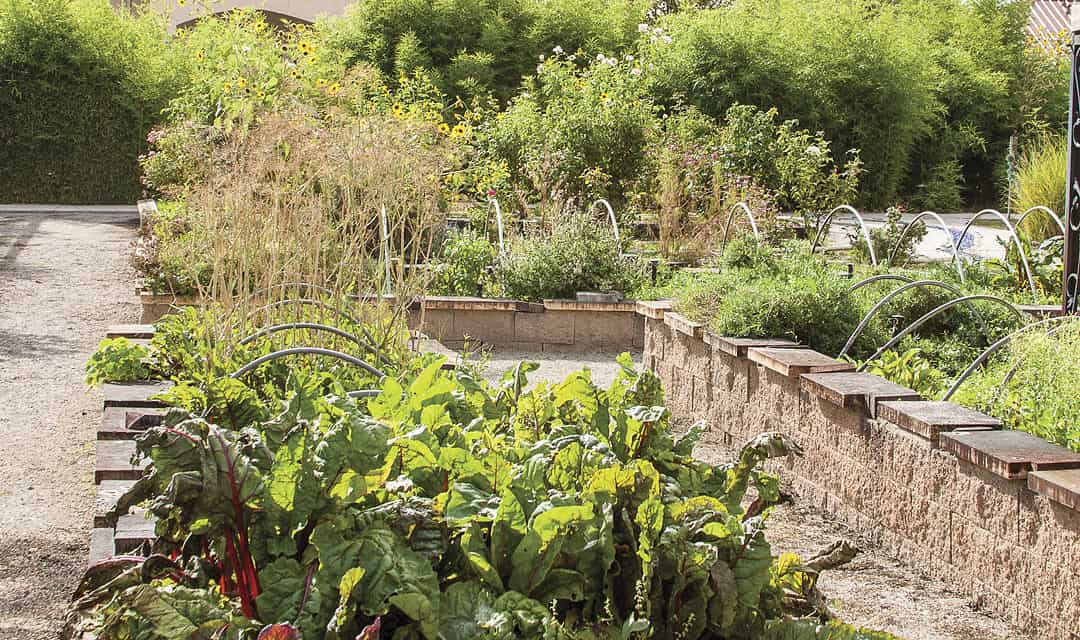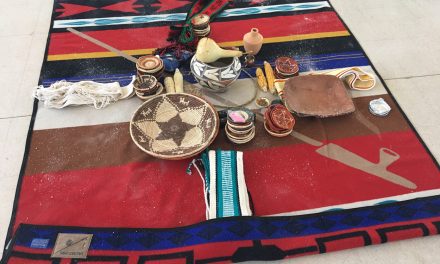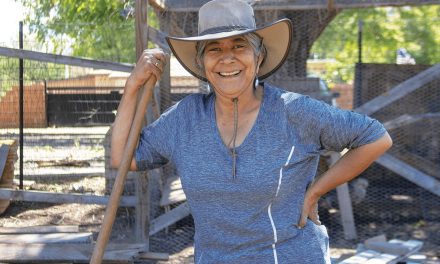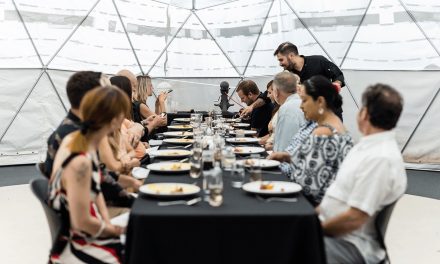Incorporating Community and Food to Help Seniors
By Valerie Ashe Photos by Stephanie Cameron
An oasis in the food desert, the Center for Ageless Living (CAL) in Tome, just east of Los Lunas, addresses the needs of seniors in its forty-five-resident community. This assisted living center not only provides nourishing food, much grown on-site, but also cares for basic human needs to sustain a healthy lifestyle in old age: fresh air, exercise, comfort, and a sense of wellbeing. CAL is also home to a day spa, salon, restaurant, event space, and small vegetable farm, all open to the public as well as residents. Suzette Lindemuth, CAL’s owner and director, says it’s important that the residents feel part of society and their surrounding community. Seeing the public come and go, watching preparations for the occasional wedding on the six-acre campus, or spending time in the garden, gives residents a sense that they are part of something bigger and that they still have a place in the world.
Issues of food security, or access to adequate healthy and culturally appropriate food, impact our most vulnerable community members. Seniors are no exception. Their struggle to protect themselves from food insecurity and hunger is greater than the general population’s. For example, seniors may have enough money to purchase food, but they might not have the resources to get to a grocery store because of a lack of transportation options, or capacity to prepare food because of physical limitations or health problems.

The US Department of Health and Human Services Administration on Aging tells us that in 2040 there will be 79.7 million older adults in the US, more than twice as many as in 2000. In 2011, 4.8 million Americans over the age of sixty were food insecure. Worse, the number of food-insecure seniors is projected to increase by fifty percent when the youngest of the Baby Boom Generation reaches age sixty in 2025.
Lindemuth recognizes the need for a different approach to senior care. In 1998 she read The Fountain of Age by Betty Friedan, whose mother was aging at the time. Friedan identified that the biggest problem for people aging in our culture is isolation. “Many elders think they want to live alone, that they have lived alone for a very long time. In reality, most seniors have lived alone for only a small fraction of their lives,” Lindemuth observes. “They grew up in families. They may have gone off to school or the military among large groups of people. Most of them raised their own families before living alone. Once they’ve lived alone awhile, they show signs of depression—not eating, not sleeping well—all a result of living in isolation.”
“Why do you think community gardens are so popular?” Lindemuth muses. “The volunteers are usually elderly women. The gardens give them a sense of belonging, a sense of community.” Lindemuth and her team want to create an environment where people feel comfortable and connected—not just senior residents, but also family members who come to visit them, and even the public. Most people who move to assisted living don’t need medical care; they need help with day-to-day living, such as getting dressed, going shopping, and preparing meals.
CAL runs on private pay with funding from the VA Pension and Aid and Attendant Program as well as Medicaid. Because the center is not owned by a large national corporation or traded on a stock exchange, Lindemuth enjoys autonomy to choose how the center is run and the food choices they offer because she and the board can make decisions quickly without waiting on funding or legislation. A decade ago, Lindemuth started purchasing food from local farmers as often as possible for residents’ meals and for the restaurant’s menu. Five years ago, she converted a two-acre parcel adjacent to the center into a large garden to supplement purchase of local food. During the fall season, she serves fresh tomatoes, chard, onions, basil, tarragon, lettuce, beets, and honey to residents and visitors, all harvested from on-site gardens.

Suzette Lindemuth, owner and director, Center for Ageless Living.
Volume and price are always a consideration for institutional food programs. New Mexico has a short growing season, limiting options, and small farms often must charge more for their produce. To supplement what she grows on-site, Lindemuth works with Amyo Farms, Sterling Gardens, Jefferson Farms, and Vida Verde Farm for other vegetables, and with Talus Wind Ranch for meat. She would love to supply more local food to residents, but seasonal local food must by supplemented by larger commercial suppliers to provide consistent and healthy meals to feed forty-five seniors three times a day.
Tastes are a challenge. Lindemuth says, “We all know what we like to eat by the time we’re adults, and many of the seniors are very particular about what they will and won’t eat. You had better have that banana at lunchtime every day, which is difficult to accommodate in a strictly local model.” Every generation that comes through the center changes. Just a few years ago, she couldn’t get most residents to eat salad. They wanted a lot of canned vegetables, because that was what was common in the era when they grew up. Now everybody wants fresh greens.
Philosophically, the way nursing homes have been built and operated hasn’t changed in decades, but the CAL takes a different approach. Management at senior facilities can change frequently, which isn’t necessarily sustainable. According to Lindemuth, the definition of sustainable is the ability to maximize one’s natural resources: time, money, shelter, or food. CAL takes sustainability seriously—at every level. For example, she had a water treatment plant installed at CAL to be able to recycle water from the facility in their gardens. CAL also uses water from on-site wells very consciously. The center has its own treatment plant and recycles as much water as possible. With the exception of paying a nominal fee each year for irrigation of the farm, CAL hasn’t paid a water bill in years, which ultimately means it has money to spend on things like better food for residents.
Lindemuth says, “The questions the senior care industry should ask itself are: Can we make long-term care affordable? How do we care for people going into their nineties as the Baby Boomer generation continues to grow old? It’s difficult to keep pace with how fast that generation is aging.” She believes if we don’t use our resources wisely, and creatively integrate systems for people, environment, and the bottom line, we can’t age sustainably. Her business model keeps senior residents as healthy as possible by reducing isolation, nourishing them with healthy food, and keeping medical costs down through healthy living.
She also believes that we’ll see more community-based aging as more people begin to understand the detriments of isolation and the benefits of care centers that prioritize good food, sustainability, and a sense of community. People should be able to age in their own communities near where they have raised their families and feel a sense of belonging. The country will see more of this model for senior living in coming years—it will continue to grow as people seek to age healthier.
05 Thomas Road, Los Lunas, 505-865-8813
nmagelessliving.info













